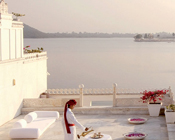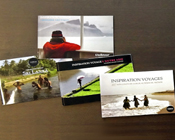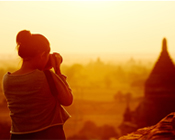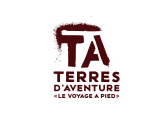French Polynesia
Geography
Tahiti and its islands cover more than 4 million km2 of maritime territory – an area roughly the same size as Europe! Of course, of this immense territory, only 4000 km2 is actually above sea level and comes in the shap of land spread over 118 islands. The island of Tahiti is part of an archipelago called the Society Islands and is located at Latitude 17°32’S and Longitude 149°34’W. It is between California (6200km) and Australia (5700km), Tokyo (7500km) and Santiago de Chile (7500km).
118 islands in 5 archipelagos
These 118 unique and idyllic islands are divided into five archipelagos, each with its own personality. The inhabitants of these archipelagos are gradually entering the 21st century – at a pace dictated by the ancestral rhythms of the sun and the ocean. The Society Islands (further split up into the Leeward Islands and Windward Islands) is a group of high islands encircled by lagoons. The main island, Tahiti, is also the largest island in French Polynesia. Its capital is Papeete.
Two beautiful volcanic mountains surge out of the ocean and form the island of Tahiti. The largest of the two, Mount Orohena (2241m), rises to 2241m from the heart of Tahiti Nui and can often be seen wearing a crown of clouds. Mount Ronui, the smaller mountain, rises to 1300m on Tahiti Iti. Connected by the isthmus of Taravao, the two halves are reminiscent of an emerald comet, bathing in the turquoise halo of their thin lagoon.
The Society Islands include:
- Tahiti
- Moorea: volcanic peaks reflected in the clam waters of its lagoon, only 17km from Tahiti across a deep sea trench
- Huahine, wild and magical island located about 175km northwest of Tahiti, full of secrets and lively traditions
- Raiatea and Tahaa, sacred islands with fertile valleys, they share a lagoon and are known for their particularly pleasant sea conditions
- Bora Bora, known across the world for the surreal beauty of its plentiful waters, its motus with coconut plantations flanked by white sands, and its coral gardens
- Maupiti, the heart-shaped island, nestled in a jade lagoon
Tuamotu-Gambier Archipelago
Between sea and sky, this group of atolls and lagoons surrounded by coral reefs is in a world of its own. Blue, white, green: three colors dominate the landscape of the Tuamotu archipelago, these simple coral rings delicately perched between the sky and the waves. Take a closer look and a whole world of magic is revealed: the lagoon’s myriad shades of turquoise, the violets and purples of the table coral visible through the iridescent surface of transparent-jade waters, the yellows, oranges, reds, black, and pinks of the underwater gardens, the mother-of-pearl whirlwind of passing fish. It barely ever rains here, and the conditions are perfect for pearl farming. Rangiroa, Tikehau, Manihi, and Fakarava are the most popular islands. At the eastern edge of Polynesia rises the high island of Mangareva and its ring of islets, the remains of an ancient crater. With few visitors, it also has its fair share of pearl farms.
The Marquesas Islands
Also known as the “Land of Men” in Marquesan (“Te Henua Enata”), these islands surge right out of the Pacific blue like dark green fortresses south of the equator, some 1500km from Tahiti. Of the twelve islands that make up this archipelago, only 6 are inhabited. The most famous ones are Nuku Hiva, Hiva Oa and Ua Pou. A great place to sail, the Marquesas offer few beaches, making each one that much more precious! Pigs, goats, sheep, and horses roam freely amid this splendid landscape.
The Austral Islands
Rurutu, Tubuai, Rimatara, Raivavae, and Rapa: these five high islands make up the southernmost group of islands in French Polynesia. The last inhabited islands in the South Pacific, these islands located way off the usual tourist trail were formed by ancient volcanoes. Apart from Rapa, these islands’ peaks are not as high as those of the other archipelagos, their landscape softer, tamer. With their Marae, ancient ritual places, their tall centuries-old stone tikis, and the still intact walls of their ancient Pa fortresses, these islands still have many secrets left to tell. Their climate allows tropical and temperate species to thrive and is well suited for market gardening, which, along with handicrafts, is the inhabitants’ main bread and butter. The Austral Islands are also on a whale migration route: each year between late July and October you can come here to meet these gentle giants.

 1 (866) 722-0909
1 (866) 722-0909
 QUOTE REQUEST
QUOTE REQUEST 





































